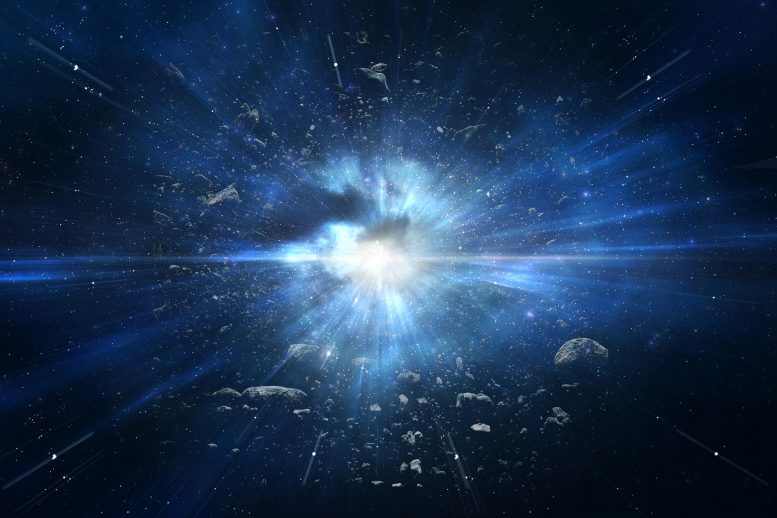
Primordial gravitational waves, produced nearly 13.8 billion years ago in the moments following the Big Bang, still echo through the universe today. Credit: MIT News
Identifying primordial ripples would be key to understanding the conditions of the early universe.
In the moments immediately following the Big Bang, the very first gravitational waves rang out. The product of quantum fluctuations in the new soup of primordial matter, these earliest ripples through the fabric of space-time were quickly amplified by inflationary processes that drove the universe to explosively expand.
Primordial gravitational waves, produced nearly 13.8 billion years ago, still echo through the universe today. But they are drowned out by the crackle of gravitational waves produced by more recent events, such as colliding black holes and neutron stars.
Now a team led by an MIT graduate student has developed a method to tease out the very faint signals of primordial ripples from gravitational-wave data. Their results are published this week in Physical Review Letters.
Gravitational waves are being detected on an almost daily basis by LIGO and other gravitational-wave detectors, but primordial gravitational signals are several orders of magnitude fainter than what these detectors can register. It’s expected that the next generation of detectors will be sensitive enough to pick up these earliest ripples.

A team led by an MIT graduate student has developed a method to tease out the very faint signals of primordial ripples from gravitational-wave data produced by more recent events, such as colliding black holes and neutron stars. Credit: Carl Knox, OzGrav/ Swinburne
In the next decade, as more sensitive instruments come online, the new method could be applied to dig up hidden signals of the universe’s first gravitational waves. The pattern and properties of these primordial waves could then reveal clues about the early universe, such as the conditions that drove inflation.
“If the strength of the primordial signal is within the range of what next-generation detectors can detect, which it might be, then it would be a matter of more or less just turning the crank on the data, using this method we’ve developed,” says Sylvia Biscoveanu, a graduate student in MIT’s Kavli Institute for Astrophysics and Space Research. “These primordial gravitational waves can then tell us about processes in the early universe that are otherwise impossible to probe.”
Biscoveanu’s co-authors are Colm Talbot of Caltech, and Eric Thrane and Rory Smith of Monash University.
A concert hum
The hunt for primordial gravitational waves has concentrated mainly on the cosmic microwave background, or CMB, which is thought to be radiation that is leftover from the Big Bang. Today this radiation permeates the universe as energy that is most visible in the microwave band of the electromagnetic spectrum. Scientists believe that when primordial gravitational waves rippled out, they left an imprint on the CMB, in the form of B-modes, a type of subtle polarization pattern.
Physicists have looked for signs of B-modes, most famously with the BICEP Array, a series of experiments including BICEP2, which in 2014 scientists believed had detected B-modes. The signal turned out to be due to galactic dust, however.
As scientists continue to look for primordial gravitational waves in the CMB, others are hunting the ripples directly in gravitational-wave data. The general idea has been to try and subtract away the “astrophysical foreground” — any gravitational-wave signal that arises from an astrophysical source, such as colliding black holes, neutron stars, and exploding supernovae. Only after subtracting this astrophysical foreground can physicists get an estimate of the quieter, nonastrophysical signals that may contain primordial waves.
The problem with these methods, Biscoveanu says, is that the astrophysical foreground contains weaker signals, for instance from farther-off mergers, that are too faint to discern and difficult to estimate in the final subtraction.
“The analogy I like to make is, if you’re at a rock concert, the primordial background is like the hum of the lights on stage, and the astrophysical foreground is like all the conversations of all the people around you,” Biscoveanu explains. “You can subtract out the individual conversations up to a certain distance, but then the ones that are really far away or really faint are still happening, but you can’t distinguish them. When you go to measure how loud the stagelights are humming, you’ll get this contamination from these extra conversations that you can’t get rid of because you can’t actually tease them out.”
A primordial injection
For their new approach, the researchers relied on a model to describe the more obvious “conversations” of the astrophysical foreground. The model predicts the pattern of gravitational wave signals that would be produced by the merging of astrophysical objects of different masses and spins. The team used this model to create simulated data of gravitational wave patterns, of both strong and weak astrophysical sources such as merging black holes.
The team then tried to characterize every astrophysical signal lurking in these simulated data, for instance to identify the masses and spins of binary black holes. As is, these parameters are easier to identify for louder signals, and only weakly constrained for the softest signals. While previous methods only use a “best guess” for the parameters of each signal in order to subtract it out of the data, the new method accounts for the uncertainty in each pattern characterization, and is thus able to discern the presence of the weakest signals, even if they are not well-characterized. Biscoveanu says this ability to quantify uncertainty helps the researchers to avoid any bias in their measurement of the primordial background.
Once they identified such distinct, nonrandom patterns in gravitational-wave data, they were left with more random primordial gravitational-wave signals and instrumental noise specific to each detector.
Primordial gravitational waves are believed to permeate the universe as a diffuse, persistent hum, which the researchers hypothesized should look the same, and thus be correlated, in any two detectors.
In contrast, the rest of the random noise received in a detector should be specific to that detector, and uncorrelated with other detectors. For instance, noise generated from nearby traffic should be different depending on the location of a given detector. By comparing the data in two detectors after accounting for the model-dependent astrophysical sources, the parameters of the primordial background could be teased out.
The researchers tested the new method by first simulating 400 seconds of gravitational-wave data, which they scattered with wave patterns representing astrophysical sources such as merging black holes. They also injected a signal throughout the data, similar to the persistent hum of a primordial gravitational wave.
They then split this data into four-second segments and applied their method to each segment, to see if they could accurately identify any black hole mergers as well as the pattern of the wave that they injected. After analyzing each segment of data over many simulation runs, and under varying initial conditions, they were successful in extracting the buried, primordial background.
“We were able to fit both the foreground and the background at the same time, so the background signal we get isn’t contaminated by the residual foreground,” Biscoveanu says.
She hopes that once more sensitive, next-generation detectors come online, the new method can be used to cross-correlate and analyze data from two different detectors, to sift out the primordial signal. Then, scientists may have a useful thread they can trace back to the conditions of the early universe.
Reference: “Measuring the Primordial Gravitational-Wave Background in the Presence of Astrophysical Foregrounds” by Sylvia Biscoveanu, Colm Talbot, Eric Thrane and Rory Smith, 9 December 2020, Physical Review Letters.
DOI: 10.1103/PhysRevLett.125.241101


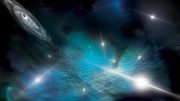
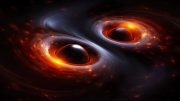
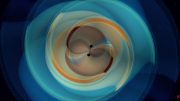
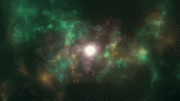
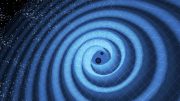


Gravitational waves can not be mirored. It is out of uderstanding of universe.
? “Mired” or “mirrored”?
Gravitational waves can be detected, which is what the article describe some work on (a new method).
Babu G. Ranganathan*
(B.A. Bible/Biology)
JUST BECAUSE SCIENCE CAN EXPLAIN how an airplane works doesn’t mean that no one designed or made the airplane. And just because science can explain how life or the universe works doesn’t mean there was no Designer and Maker behind them.
Natural laws may explain how the order in the universe works and operates, but mere undirected natural laws cannot explain the origin of that order. Once you have a complete and living cell then the genetic code and biological machinery exist to direct the formation of more cells from raw materials such as amino acids and other chemicals, but how could life or the cell have naturally originated when no directing code and mechanisms existed in nature? Read my Internet article: HOW FORENSIC SCIENCE REFUTES ATHEISM.
WHAT IS SCIENCE? Science simply is knowledge based on observation. No human observed the universe coming by chance or by design, by creation or by evolution. These are positions of faith. The issue is which faith the scientific evidence best supports.
SCIENCE SHOWS THAT THE UNIVERSE CANNOT BE ETERNAL because it could not have sustained itself eternally due to the law of entropy (increasing and irreversible net energy decay, even in an open system). Even a hypothetical oscillating universe could not continue to oscillate eternally! Einstein’s General Theory of Relativity shows that space, matter, and time all are physical and all had a beginning. Space even produces particles because it’s actually something, not nothing. What about the Higgs boson (the so-called “God Particle”)? The Higgs boson, even if it existed, would not have created mass from nothing, but rather it would have converted energy into mass. Einstein showed that all matter is some form of energy. Even time had a beginning! Time is not eternal.
The law of entropy doesn’t allow the universe to be eternal. If the universe were eternal, everything, including time (which modern science has shown is as physical as mass and space), would have become totally entropied by now and the entire universe would have ended in a uniform heat death a long, long time ago. The fact that this hasn’t happened already is powerful evidence for a beginning to the universe.
Popular atheistic scientist Stephen Hawking admits that the universe had a beginning and came from nothing but he believes that nothing became something by a natural process yet to be discovered. That’s not rational thinking at all, and it also would be making the effect greater than its cause to say that nothing created something. The beginning had to be of supernatural origin because science teaches us from the First Law of Thermodynamics that natural laws and processes do not have the ability to bring something into existence from nothing.
The supernatural origin of the universe cannot be proved by science but science points to a supernatural intelligence and power for the origin and order of the universe. Where did God come from? Obviously, unlike the universe, God’s nature doesn’t require a beginning.
The disorder in the universe can be explained because of chance and random processes, but the order can be explained only because of intelligence and design.
Gravity may explain how the order found in the precise and orderly courses of thousands of billions of stars is maintained, but gravity cannot explain the origin of that order.
Some evolutionary astronomers believe that trillions of stars crashed into each other leaving surviving stars to find precise orderly orbits in space. Not only is this irrational, but if there was such a mass collision of stars then there would be a super mass residue of gas clouds in space to support this hypothesis. The present level of residue of gas clouds in space doesn’t support the magnitude of star deaths required for such a hypothesis. And, as already stated, the origin of stars cannot be explained by the Big Bang because of the reasons mentioned above. It’s one thing to say that stars may decay and die into random gas clouds, but it is totally different to say that gas clouds form into stars.
Even the father of Chaos theory admitted that the “mechanisms” existing in the non-living world allow for only very rudimentary levels of order to arise spontaneously (by chance), but not the kind or level of order we find in the structures of DNA, RNA, and proteins. Yes, individual amino acids have been shown to come into existence by chance but not protein molecules which require that the various amino acids be in a precise sequence just like the letters found in a sentence.
Some things don’t need experiment or scientific proof. In law there is a dictum called prima facie evidence. It means “evidence that speaks for itself.”
An example of a true prima facie would be if you discovered an elaborate sand castle on the beach. You don’t have to experiment to know that it came by design and not by the chance forces of wind and water.
If you discovered a romantic letter or message written in the sand, you don’t have to experiment to know that it was by design and not because a stick randomly carried by wind put it there. You naturally assume that an intelligent and rational being was responsible.
It’s interesting that Carl Sagan would have acknowledged sequential radio signals in space as evidence of intelligent life sending them, but he wouldn’t acknowledge the sequential structure of molecules in DNA (the genetic code) as evidence of an intelligent Cause. Read my popular Internet article, HOW DID MY DNA MAKE ME.
I encourage all to read my popular Internet articles:
NATURAL LIMITS TO EVOLUTION
HOW FORENSIC SCIENCE REFUTES ATHEISM
Visit my latest Internet site: THE SCIENCE SUPPORTING CREATION (This site answers many arguments, both old and new, that have been used by evolutionists to support their theory)
Author of popular Internet article, TRADITIONAL DOCTRINE OF HELL EVOLVED FROM GREEK ROOTS
*I have given successful lectures (with question and answer period afterwards) defending creation before evolutionist science faculty and students at various colleges and universities. I’ve been privileged to be recognized in the 24th edition of Marquis “Who’s Who in The East” for my writings on religion and science.
Superstition, and pseudoscience references, not a single correct claim. C.f. “Evolution” @ Wikipedia and “Big Bang” @ Wikipedia for the facts.
Paper is 2009.04418 @ arxiv.
As I suspected, even with their new bayesian method which is “a unified, statistically optimal approach” for simultaneous detection of foreground and background, which works well with SNR > 7, they have to expect either unexpected early processes or later space-based detectors (e.g. LISA with planned launch 2034).
“In the simplest form of inflation, the dimensionless energy density of the background,
Ω_gw(f) ≡ 1/ρ_c dρ_gw/d ln f , (1)
is expected to be Ω_gw(f) ≈ 10^−15 across many orders of magnitude in frequency f [1]. Here, dρ_gw is the gravitational-wave energy density between f and f + df while ρ_c is the critical energy density for a flat universe.”
So if the observed slow roll inflation fluctuates at 10^-5 Ω_total as seen in the cosmic background spectra, this is 10 orders of magnitude weaker. No wonder BICEP2 didn’t see anything!
Instead they hope against observations for “either non-standard inflation or non-standard cosmology”, alternatively “for the inflaton to decay nonperturbatively through parametric resonance” which also wouldn’t seem to happen happen with a slow roll inflation at 10^-5 Ω_total fluctuations. That is not O(1) strength fluctuations but low enough to mean perturbative quantum field physics during decay I would think.
Finally there is a possibility for “strongly first-order” phase transitions as the hot big bang cools and the fields with it. But we already know that the standard model electroweak phase transition was smooth second-order from its observed parameters (e.g. Higgs mass), so that too starts to look iffy.
So likely we have to wait until the 2040s before this will give something.
Interesting.
Some Thoughts for consideration.
1. Can Current Inflation of the Universe be followedby Contraction to create extremely dense Black Holes which then transition to mini balck holes and emerge in another time-space -SPACE as an expanding Universe which appears to be expanding to a observerin that Universe and seems to have emerged from Nothing? Hawkins – inspired.
2.CMB really left from the Big Bang? Some Thoughts :
(a) Why limit tth Search to only the most visible part of the electromagnetic spectrum?
(b)To get to the Primordial gravitational wave , the assumption that no gravitational background wave existed “pre big-bang” may be incorrect. Duality in a two dimensional space-time world, appears to indicate that the gross visible observations , can exist as both a wave and also as a particle. Hence, it may be necessary to subtract both foreground and pre-existong background radiation , to arrive at the Primordial Gravitational wave — if there was a Big Bang ,when Something emerged from Nothing!
3. Here is a radical thought. Could Universe and Time just exist and be conceptual in nature? Our observations of astronomical events could be governed by the distinction between space and time as separate entities in the Space-Time Contiuum? Could the space-time Continuum be cyclical in nature and be like a beating heart and exand and contract , similar to when we breathe?
4. Best of luck to LISA (2034 launch?) in the attempt to search for and detect the Primordial Gravitational Wave. For all we know, it may a gravitational partcle? Or maybe a wave?
Would like to understand the mathematics of above assumptions. Views expressed are Personal and not binding on anyone.
I’m impressed to say the least I am the one
This pheñomena of detection of gravìtational wave coming from galaxies formed since just after Big Bang 13.8 billion years before is now viewing as justified from recent discoveries in astrophysics.Light with characterstic time periòd of fĺickering brightness
comes from the corona enciirculating
SMBH is quite ŕational to the SMBH mass.These are the equivaĺent gravitationaĺ waves.Aĺso,the much hot corona aroud SMBH producing electromagnetic waves aĺongwith ĺigt are CMB radiations.
Some recent dìscoveries òf astrophysics are ìn ĺine to support this phenomena of primordial gravitational wave identifying emitted by galaxies fòrmedjust after big bang 13.8 billion years before.To mention we can cite a discòvery that relates light emitted from the corona aròud SMBH of a galaxy(for 69such cases) for characterstic time period of flickering brightness is proportional to the SMBH mass.Ñow these light waves are equìvalelent togravitational waves as òriginò.However,this must be universal to all the galaxies,with only difference in rotation to be measured.Again,from the very hot còrona from edge electromagnetic radiation of all kinds ejected alongwith light are equivalent to CMB radiation.This is a fraction of CMB radiation equivalent of gravitational wave fròm a galaxy by corona of super massive black hole singularity to our observation in milkywal perfectĺy aligned with space time.
Fantastic read,twice in fact. ⚫ corona waves🌊see the light.all those words by the comment people strange 🙄 words. Excellent article of research.